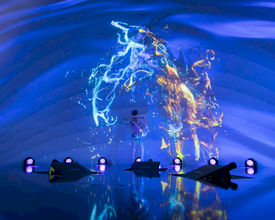There are considerable grounds for optimism when the pro AV industry converges once again on Amsterdam in February. Here is an overview of some of the technologies driving market growth.
Integrated Systems Europe (ISE) has long been the go-to event for discovering the latest market and technology trends in the professional audiovisual (AV) industry – and ISE 2020 will be no different. Visitors can expect to sense enormous confidence in the halls, not least because AVIXA’s 2019 AV Industry Outlook and Trends Analysis (IOTA) Global Summary saw the organisation raise its growth forecast, reflecting, it said, strong economies and demand for new products and services. From €224billion in 2019, AVIXA now believes 2024 will see worldwide revenues for the industry reach €296 billion – outpacing global GDP growth.
CEDIA’s research gives similar grounds for optimism. The UK alone, for example, represents a market valued at around €779 million, with home cinema installs rising 9% and 80% of participants in a CEDIA survey expressing confidence that their revenues would rise over the coming year.
It’s widely agreed that the success of both the commercial and residential sectors is a function of two key drivers: the proven value that AV solutions deliver, and the AV industry’s continuing embrace of new technologies. In the commercial world, AV is evolving from being ‘nice-to-have’ into a highly strategic asset.
Growing importance of AI
A recurring theme throughout the event is likely to be the growing importance of AI and machine learning. In smart homes, for example, ISE visitors can expect to see growing evidence of manufacturers embracing the likes of Alexa and Google Assistant – both enabled by AI – responding to consumer desire for a more integrated ‘one ring to rule them all’ unified environment. That’s becoming increasingly important as growing numbers of home devices and appliances become IoT-enabled. ISE 2020 will reflect this shift in the connected homes market.
On the commercial side, AI – especially in conjunction with sensors such as embedded cameras – is rapidly finding a place in digital signage (a market forecast by AVIXA to be worth $45 billion by 2024 – roughly 35% larger than 2019) as retailers especially look to try to create more personalised, more engaging, more relevant consumer experiences. In fact, researchers expect the pro AV industry to see greater adoption of AI in any market where customer experience is important, such as hospitality and healthcare. Hospitality companies will spend vast sums on AV in the coming years in order to meet and exceed the expectations of a travelling public deeply rooted in technology.
AI is also believed to have the potential to transform unified communications and collaboration – and is already finding its way into AV solutions designed for education, where research indicates that almost nine out of ten pupils and students are now leveraging the benefits of AV technology for learning. Whatever the vertical market, ISE visitors can expect to see plenty of evidence of AI – including XR (extended reality) – being embedded across a number of platforms.
LED proliferation
AI is very much a ‘behind the scenes’ technology. One of the most visible manifestations of change in the industry is the rapid rise in popularity of LED as the screen technology of choice. Not only does it bring unique advantages in the creative deployment of displays such as videowalls, but also, as its price declines, it is starting to displace single LCD screens. ISE 2020 is likely to provide further evidence of LED’s proliferation – and in the residential systems market too as ‘multi-screen’ becomes the new trend for home theatre installs.
A recurring question, however, is how long LED will enjoy its current place in the sun. OLED technology has numerous theoretical advantages in terms of image quality, installability and the opportunity for highly creative deployments. It’s still, however, not without its challenges – notably in the area of price – and ISE 2020 will provide an opportunity to assess the progress it’s making toward prime time.
A perhaps surprising fact is that, in the face of stiff competition from flat panel displays, the projector market remains remarkably vibrant as it reinvents itself. Having largely eliminated the reasons not to buy – predominantly cost of ownership – with solid state illumination, new generations of projector are becoming increasingly application-specific. The success of projection isn’t limited to the commercial market: PMA Research reports that worldwide sales of 1080p consumer projectors have risen by nearly 30% year-on-year.
It’s not all about images on screens, however. So called ‘object-based audio’ has taken the sound world by storm with its ability to deliver wholly immersive sound stages. Advances in the ‘placing’ of sound are being matched by increasingly sophisticated DSPs that can ‘tune’ an installation to create the optimum match with the acoustics of the room. Together, they’re creating some jaw-dropping aural experiences – and those will be demonstrated at ISE. Audio is no less affected by the progressive ‘IT-ification’ of the AV industry, and visitors can expect to see numerous new audio-over-IP products – not to mention a plethora of AV-over-IP platforms.
Those platforms – distributing video, audio, control signals and more over IP networks – are becoming increasingly commonplace, and ISE 2020 visitors can expect to find more as the worlds of AV and IT progressively converge, bringing new levels of flexibility, interoperability and scalability – not to mention security. Concerns about loss of image and sound quality have all but been eradicated.
What’s exciting about ISE, however – and ISE 2020 will be no different – is not just finding out about the latest developments in today’s AV technology. Where the excitement really comes in is when you get taken by surprise by something that you didn’t expect. To find out what those surprises are, there’s no substitute for being in Amsterdam in February.







